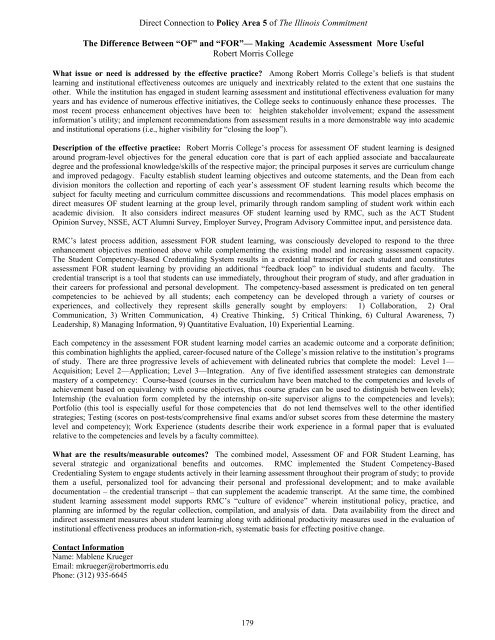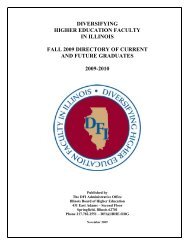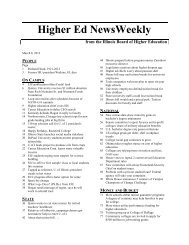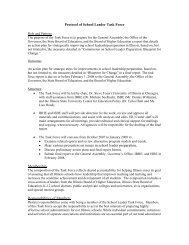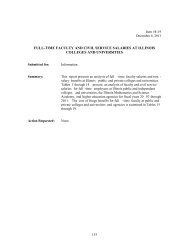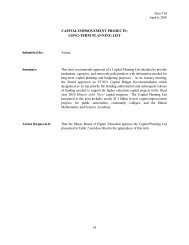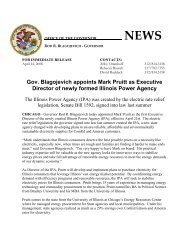Title of Effective Practice: - California Postsecondary Education ...
Title of Effective Practice: - California Postsecondary Education ...
Title of Effective Practice: - California Postsecondary Education ...
Create successful ePaper yourself
Turn your PDF publications into a flip-book with our unique Google optimized e-Paper software.
Direct Connection to Policy Area 5 <strong>of</strong> The Illinois Commitment<br />
The Difference Between “OF” and “FOR”— Making Academic Assessment More Useful<br />
Robert Morris College<br />
What issue or need is addressed by the effective practice? Among Robert Morris College’s beliefs is that student<br />
learning and institutional effectiveness outcomes are uniquely and inextricably related to the extent that one sustains the<br />
other. While the institution has engaged in student learning assessment and institutional effectiveness evaluation for many<br />
years and has evidence <strong>of</strong> numerous effective initiatives, the College seeks to continuously enhance these processes. The<br />
most recent process enhancement objectives have been to: heighten stakeholder involvement; expand the assessment<br />
information’s utility; and implement recommendations from assessment results in a more demonstrable way into academic<br />
and institutional operations (i.e., higher visibility for “closing the loop”).<br />
Description <strong>of</strong> the effective practice: Robert Morris College’s process for assessment OF student learning is designed<br />
around program-level objectives for the general education core that is part <strong>of</strong> each applied associate and baccalaureate<br />
degree and the pr<strong>of</strong>essional knowledge/skills <strong>of</strong> the respective major; the principal purposes it serves are curriculum change<br />
and improved pedagogy. Faculty establish student learning objectives and outcome statements, and the Dean from each<br />
division monitors the collection and reporting <strong>of</strong> each year’s assessment OF student learning results which become the<br />
subject for faculty meeting and curriculum committee discussions and recommendations. This model places emphasis on<br />
direct measures OF student learning at the group level, primarily through random sampling <strong>of</strong> student work within each<br />
academic division. It also considers indirect measures OF student learning used by RMC, such as the ACT Student<br />
Opinion Survey, NSSE, ACT Alumni Survey, Employer Survey, Program Advisory Committee input, and persistence data.<br />
RMC’s latest process addition, assessment FOR student learning, was consciously developed to respond to the three<br />
enhancement objectives mentioned above while complementing the existing model and increasing assessment capacity.<br />
The Student Competency-Based Credentialing System results in a credential transcript for each student and constitutes<br />
assessment FOR student learning by providing an additional “feedback loop” to individual students and faculty. The<br />
credential transcript is a tool that students can use immediately, throughout their program <strong>of</strong> study, and after graduation in<br />
their careers for pr<strong>of</strong>essional and personal development. The competency-based assessment is predicated on ten general<br />
competencies to be achieved by all students; each competency can be developed through a variety <strong>of</strong> courses or<br />
experiences, and collectively they represent skills generally sought by employers: 1) Collaboration, 2) Oral<br />
Communication, 3) Written Communication, 4) Creative Thinking, 5) Critical Thinking, 6) Cultural Awareness, 7)<br />
Leadership, 8) Managing Information, 9) Quantitative Evaluation, 10) Experiential Learning.<br />
Each competency in the assessment FOR student learning model carries an academic outcome and a corporate definition;<br />
this combination highlights the applied, career-focused nature <strong>of</strong> the College’s mission relative to the institution’s programs<br />
<strong>of</strong> study. There are three progressive levels <strong>of</strong> achievement with delineated rubrics that complete the model: Level 1—<br />
Acquisition; Level 2—Application; Level 3—Integration. Any <strong>of</strong> five identified assessment strategies can demonstrate<br />
mastery <strong>of</strong> a competency: Course-based (courses in the curriculum have been matched to the competencies and levels <strong>of</strong><br />
achievement based on equivalency with course objectives, thus course grades can be used to distinguish between levels);<br />
Internship (the evaluation form completed by the internship on-site supervisor aligns to the competencies and levels);<br />
Portfolio (this tool is especially useful for those competencies that do not lend themselves well to the other identified<br />
strategies; Testing (scores on post-tests/comprehensive final exams and/or subset scores from these determine the mastery<br />
level and competency); Work Experience (students describe their work experience in a formal paper that is evaluated<br />
relative to the competencies and levels by a faculty committee).<br />
What are the results/measurable outcomes? The combined model, Assessment OF and FOR Student Learning, has<br />
several strategic and organizational benefits and outcomes. RMC implemented the Student Competency-Based<br />
Credentialing System to engage students actively in their learning assessment throughout their program <strong>of</strong> study; to provide<br />
them a useful, personalized tool for advancing their personal and pr<strong>of</strong>essional development; and to make available<br />
documentation – the credential transcript – that can supplement the academic transcript. At the same time, the combined<br />
student learning assessment model supports RMC’s “culture <strong>of</strong> evidence” wherein institutional policy, practice, and<br />
planning are informed by the regular collection, compilation, and analysis <strong>of</strong> data. Data availability from the direct and<br />
indirect assessment measures about student learning along with additional productivity measures used in the evaluation <strong>of</strong><br />
institutional effectiveness produces an information-rich, systematic basis for effecting positive change.<br />
Contact Information<br />
Name: Mablene Krueger<br />
Email: mkrueger@robertmorris.edu<br />
Phone: (312) 935-6645<br />
179


